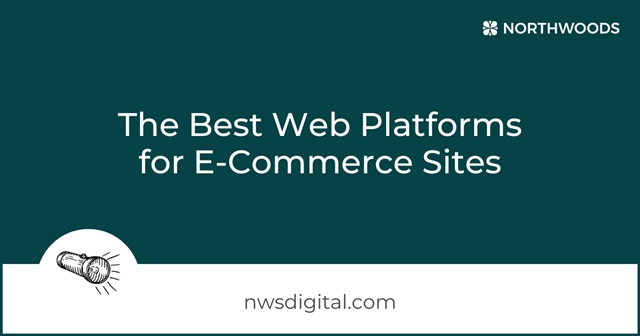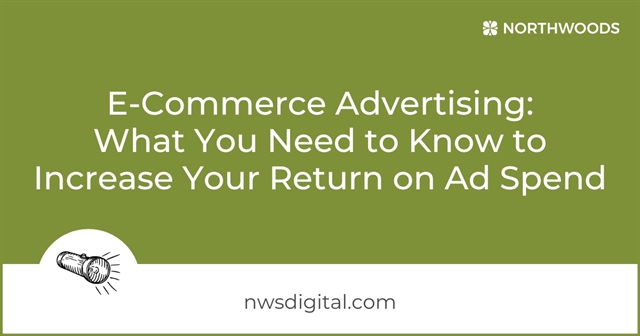By Northwoods Team
October 2, 2023
5 Minute Read
Research indicates that in 2024 the e-commerce industry will top $1 trillion USD in revenue and account for 20% of all retail sales in the U.S. alone. So failure to launch an effective, user-friendly e-commerce website isn’t an option. We’re here to help, starting with this 10-step guide to the technical and business aspects of creating a successful e-commerce website.
Step 1: Define Your Niche and Target Audience
Define your business objectives. Be specific. Pinpoint how your products will stand out from those of your competitors. Know specifically how your products will meet the needs, satisfy the preferences, and resolve the issues of your customers and prospective customers.
This knowledge will inform your product curation, branding, and overall marketing strategies. Only then can you move on to step two.
Step 2: Select Your E-Commerce Platform
Choosing an e-commerce platform is crucial. Popular options include WooCommerce for WordPress (Northwoods can help with that), BigCommerce, Shopify and others.
Among the numerous other options, some don’t scale well and some are specific to certain types of businesses. When you choose a platform, think ahead. You might start small, but prepare from the start for your business to grow. Consider scalability, customization options, and integration capabilities, along with price point.
Check out our Best Web Platforms for E-Commerce Sites post for more insights and advice, and this Forbes guide to top e-commerce platforms is well-worth a read, as well.
Step 3: Pick a Domain and Hosting Service
Now that you have your platform, it’s time to get into the technical weeds. Choose a domain name that’s either your company name or reflects your brand perfectly. Next, invest in reliable hosting to ensure that your website remains fast and accessible.
Many of the top e-commerce platforms offer all-in-one hosting services, domain purchases, and SSL certificates (to secure your customer data). For WordPress sites, we recommend WP Engine for its excellent customer support, top-in-class security, and reliable hosting for more than 1.5 million sites on WordPress.
Step 4: Focus on User Design
User-friendly design is essential. Google and other search engines penalize sites in search rankings for poor mobile responsive design and poor user experience. Dedicate generous resources, whether in-house or contract, to the sitemap, design elements, and page layouts.
Pre-designed templates are great starting points, but customize your template to fit your brand and distinguish your site from those of your competitors. Above all, prioritize mobile responsiveness for seamless browsing on all devices.
Step 5: Add Product Listings
Add your products systematically to your site. Include high-quality images and detailed descriptions and pricing. (Think of your e-commerce as sales staff.) Implement inventory management software or invest in such software if your platform doesn’t include it.
Track stock levels to avoid overselling. Get the design right the first time. Cleaning up a poorly designed shop front is tedious, time-consuming, and costly. So be patient; don’t rush the launch.
Step 6: Integrate a Payment Processor
Pick a secure payment gateway such as PayPal, Stripe, or Authorize.Net to facilitate transactions. Analyze their fee structures for business size, type, and expected volume. Ensure seamless checkout experiences, especially on mobile, to reduce cart abandonment rates.
Check for PCI compliance before launch to be sure to handle credit cards and secure information in an industry-approved way.
Triple-check pricing. Don’t launch your e-commerce site without adding proper shipping costs or sales tax. And don’t forget coupon codes, affiliate/influence codes, bulk discounts, and sales codes.
Step 7: Implement Robust Security Measures
Security is paramount in e-commerce. Regularly update your website software, use a Web Application Firewall (WAF), and employ secure sockets layer (SSL) encryption. Protect customer data at all costs. Two-factor authentication for account logins, reCAPTCHA to prevent spam attacks on forms, and password requirements for users all enhance customer and site security.
It's critical to educate yourself and your staff about the threats your business can face. Be vigilant, and encourage and enable your customers to be vigilant, too. No site can be 100% safe, but site owners owe it to themselves and their customers to be as secure as possible.
Step 8: Optimize Your Site for SEO
Enhance your website's visibility in search engines through search engine optimization. Research relevant keywords, optimize product pages, and create quality content to boost organic traffic.
For image-rich e-commerce sites, focus on labeling your images with titles, alt-text, and descriptions. This makes the images searchable on Google, which can bring traffic and sales to your site.
Step 9: Develop a Comprehensive Marketing Strategy
Develop a robust marketing strategy that suits your business. Tactics can include content marketing, social media posting and advertising, social commerce, email marketing, remarketing, and pay-per-click (PPC) campaigns, among others.
A good paid marketing campaign relies on underlying good content, quality products, and a base level of organic traffic. Launching a huge Google PPC or Facebook Ad campaign with a poor site or limited social media following will yield little. Monitor performance analytics tools and let their data drive your decisions.
Step 10: Monitor and Optimize Performance
Constantly monitor your website's performance with tools such as Google Analytics. It’s critical to ensure you’ve enabled Enhanced E-Commerce to actively track key e-commerce metrics such as product impression, promotions, and sales data, as well as checkout stats. Use this data to continuously optimize your website, product offerings, and marketing strategies. (If you need help setting up Enhanced E-Commerce in GA4, our expert team can help.)
Along with monitoring site performance, actively seek customer feedback. Customers can be one of your best marketing assets – offering an exceptional e-commerce experience can result in glowing reviews and shared social media posts that can go a long way in driving quality traffic to your site.
Need help building an effective, user-friendly e-commerce website? Our expert team is ready to help. Reach out to us!
Related Blog Posts

Position your e-commerce site – and your business – for success with these SEO tips that will help increase traffic, improve search rankings, and boost conversions.

We’ve broken down some of the most popular e-commerce tools by usability, scale, and technical capacity so you can make the best choice for your business.

A thoughtful, nuanced ad strategy will set your e-commerce business up for long-term success. Here are the key strategies you'll need to employ to increase your return on ad spend.